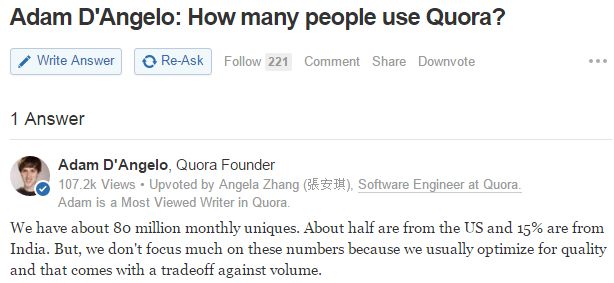A Quoran recently asked me where he could sell his email list in India.
Normally, my Quora answers are quite concise. And, after seeing the following reply by Quora’s Founder Adam D. Angelo, I stopped worrying if I was too terse:
But the said question about email list gave me a chance to throw light on the differences in buying behaviors in different countries. Therefore, I wrote a rather long answer and, because these differences can shape the GTM strategies of B2B technology providers, I thought of repurposing it into this blog post.
Where can I sell an email list in India?
Short answer: Nowhere.
Long answer:
I’m assuming your list is targeted at a B2B company (e.g. CRM product vendor or ERP implementation service provider) rather than at a B2C company (say, retailer).
With that preamble in place, let me explain my answer with a personal example.
 My company offers an email list that can be used for business development by SAP ISVs and Services Providers all over the world. This product has been selling briskly in USA ever since we launched it seven years ago. During the same period, we’ve received countless leads for this product from companies in India. However, not a single one of them has converted into a deal so far.
My company offers an email list that can be used for business development by SAP ISVs and Services Providers all over the world. This product has been selling briskly in USA ever since we launched it seven years ago. During the same period, we’ve received countless leads for this product from companies in India. However, not a single one of them has converted into a deal so far.
Seven years is a long enough period. Why is there such a drastic difference in sales of the same product that’s prima facie valuable for both markets?
I tend to believe it’s because there’s a fundamental difference in the way technology companies do business in these two markets.
When they first hear about this list, both American and Indian companies believe they can compile it by themselves. They’re right – we say so ourselves on our website.
Companies planning to launch campaigns to existing SAP sites can always build a lead list internally. However, there’s no single – free or paid – source of contact information regarding SAP installed base. As a result, they need to spend a lot of time and money to gather company names from one source, identify decision makers from another source and buy contact information from a third source. By the time their lead list is ready, their sales team’s enthusiasm might start waning, their window of opportunity might pass, or both.
However, from here, their approach diverges.
At the risk of taking a major leap of faith based on a datapoint of one, I think that American companies are driven by revenue whereas Indian companies are driven by cost.
Revenue-driven approach
Wow, now that I can buy it, I don’t need to spend the next 2-3 months to compile the list inhouse. By buying this list, I can launch an outreach campaign immediately and win a few deals within a couple of months. Therefore, I can earn revenues even before I’d finish compiling the list internally. Therefore, I’ll buy this list. Ergo, we bagged hundreds of deals for SAP Mailing List from USA.
Cost-driven approach
Why should I incur a cost when I can put my people on the job to compile it inhouse? Therefore, I won’t buy this list. Ergo, we bagged zero deals for SAP Mailing List from India. (This approach ignores the opportunity cost of not earning revenues earlier caused by the delayed launch of the outreach campaign, but that’s a topic for another blog post.)
Nothing right, nothing wrong, each to his own way and all that, but that’s why our email list sells in USA and hasn’t sold in India.
Some markets are “money rich, time poor” whereas others are “time rich, money poor”. Revenue enhancement mindset dominates the former and cost reduction mindset dominates the latter.
I tend to believe that this deep-rooted reason will shape the purchase behavior of technology products and services in different markets. IT product and services vendors might want to keep it on their radar to predict what will sell where while navigating the uncharted waters of formulating their market entry plans. While Confucius won’t think highly of them, they will succeed in allocating their marketing budgets in such a way that they will get the maximum bang for their buck.
Like we did – we stopped advertising for SAP Mailing List in India and increased the ad spend in USA.

